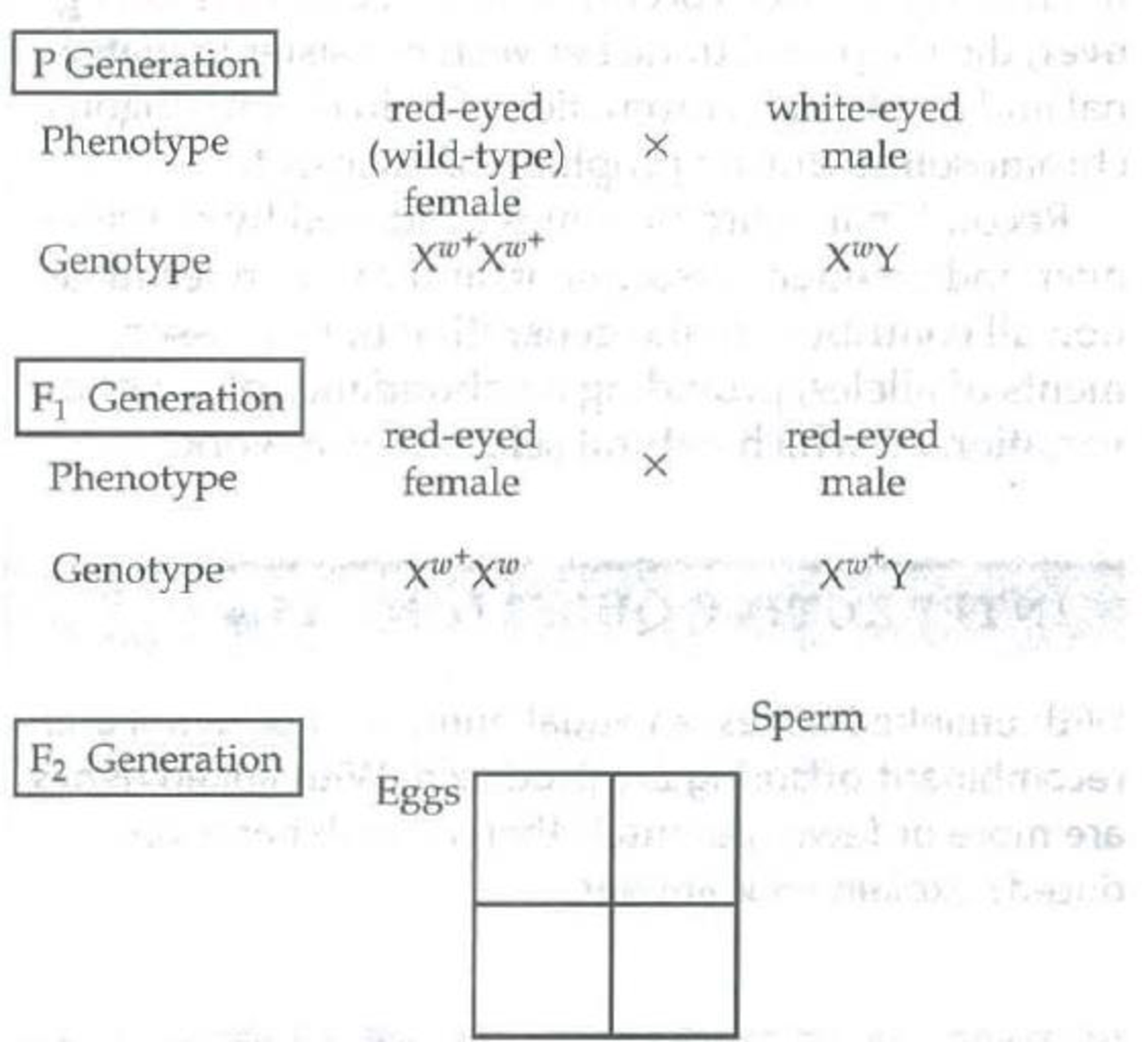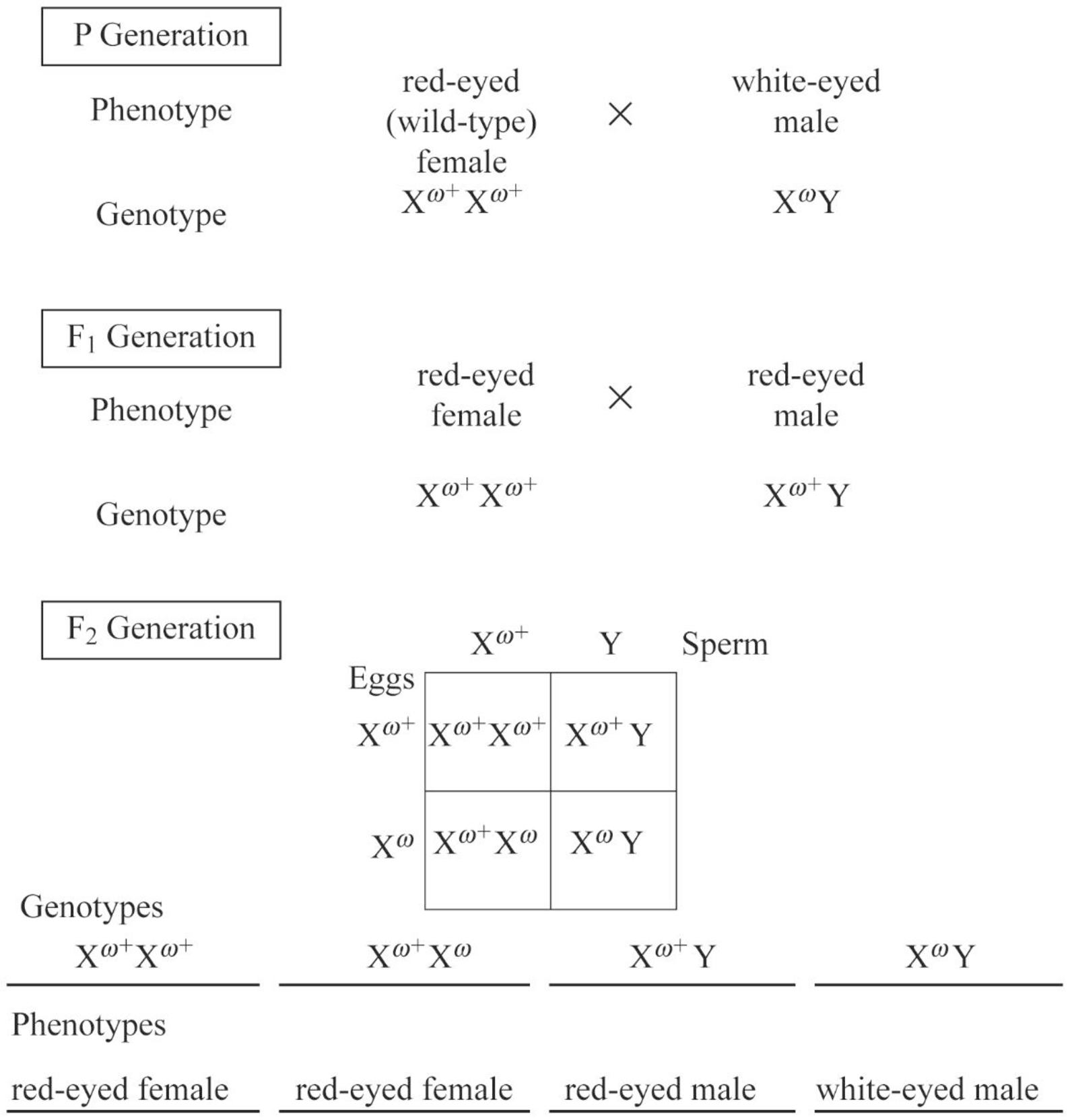
Concept explainers
Complete the following summary of Morgan’s crosses involving the mutant white-eyed fly by filling in the Punnett square and indicating the genotypes and

Genotypes
_____ _____ _____ _____
Phenotypes
_____ _____ _____ _____
To complete: The summary of Morgan’s cross that involves the mutant white-eyed fly by filling in the Punnett square and by indicating the genotypes and phenotypes of the F2 generation.
Introduction: Sex chromosomes are those chromosomes that play a crucial role in determination of sex of the individual. They have important function in the development of sexual characteristics in the organisms.
Answer to Problem 1IQ
Pictorial representation: Fig.1 represents the summary of Morgan’s cross that involves the mutant white-eyed fly by filling in the Punnett square and by indicating the genotypes and phenotypes of the F2 generation.

Fig.1: Morgan’s cross of mutant white-eyed fly with the genotypes and phenotypes of the F2 generation
Explanation of Solution
The X and Y chromosomes act as sex chromosomes in most of the organisms. The genes that are present on the sex chromosome are called sex-linked genes. There are approximately 1,100 X-linked genes. On the other hand, Y chromosome contains relatively very few genes.
The sex-linked genes display a unique pattern of inheritance. The expression of recessive X-linked trait requires two copies of alleles in females (homozygous) and only one copy of the allele in males (hemizygous). The probability of a male to receive a single mutated X-linked gene from their mother is high as compared to a female receiving both the X-linked mutated genes from the mother (carrier) and father (carrier).
When Morgan crossed red-eyed female (wild-type) with white-eyed male (mutant), all the offspring were red-eyed in the first generation (F1). Then, he again crossed the F1red-eyed female to the red-eyed male of F1. The typical ratio of 3:1 (red-eyed flies: white eyed flies) was observed in the F2 generation, but all white-eyed flies were males.
Morgan concluded that this could be due to hemizygous condition (presence of single X-chromosome “XW+Y”) of the males. Females required both the mutated alleles to express the phenotype (white eye color), while males needed only one mutated allele to show the phenotype. The probability to inherit both mutated copies is less.
Hence, four genotypes of F2 generation are as follows:
- XW+XW+
- XW+XW
- XW+Y
- XWY
The four phenotypes of F2 generation are as follows:
- Red-eyed female
- Red-eyed female
- Red-eyed male
- White-eyed male.
Want to see more full solutions like this?
Chapter 15 Solutions
Study Guide for Campbell Biology
Additional Science Textbook Solutions
Campbell Biology in Focus (2nd Edition)
Cosmic Perspective Fundamentals
Applications and Investigations in Earth Science (9th Edition)
Campbell Biology: Concepts & Connections (9th Edition)
Microbiology: An Introduction
Biology: Life on Earth (11th Edition)
- What is this?arrow_forwardMolecular Biology A-C components of the question are corresponding to attached image labeled 1. D component of the question is corresponding to attached image labeled 2. For a eukaryotic mRNA, the sequences is as follows where AUGrepresents the start codon, the yellow is the Kozak sequence and (XXX) just represents any codonfor an amino acid (no stop codons here). G-cap and polyA tail are not shown A. How long is the peptide produced?B. What is the function (a sentence) of the UAA highlighted in blue?C. If the sequence highlighted in blue were changed from UAA to UAG, how would that affecttranslation? D. (1) The sequence highlighted in yellow above is moved to a new position indicated below. Howwould that affect translation? (2) How long would be the protein produced from this new mRNA? Thank youarrow_forwardMolecular Biology Question Explain why the cell doesn’t need 61 tRNAs (one for each codon). Please help. Thank youarrow_forward
- Molecular Biology You discover a disease causing mutation (indicated by the arrow) that alters splicing of its mRNA. This mutation (a base substitution in the splicing sequence) eliminates a 3’ splice site resulting in the inclusion of the second intron (I2) in the final mRNA. We are going to pretend that this intron is short having only 15 nucleotides (most introns are much longer so this is just to make things simple) with the following sequence shown below in bold. The ( ) indicate the reading frames in the exons; the included intron 2 sequences are in bold. A. Would you expected this change to be harmful? ExplainB. If you were to do gene therapy to fix this problem, briefly explain what type of gene therapy youwould use to correct this. Please help. Thank youarrow_forwardMolecular Biology Question Please help. Thank you Explain what is meant by the term “defective virus.” Explain how a defective virus is able to replicate.arrow_forwardMolecular Biology Explain why changing the codon GGG to GGA should not be harmful. Please help . Thank youarrow_forward
- Stage Percent Time in Hours Interphase .60 14.4 Prophase .20 4.8 Metaphase .10 2.4 Anaphase .06 1.44 Telophase .03 .72 Cytukinesis .01 .24 Can you summarize the results in the chart and explain which phases are faster and why the slower ones are slow?arrow_forwardCan you circle a cell in the different stages of mitosis? 1.prophase 2.metaphase 3.anaphase 4.telophase 5.cytokinesisarrow_forwardWhich microbe does not live part of its lifecycle outside humans? A. Toxoplasma gondii B. Cytomegalovirus C. Francisella tularensis D. Plasmodium falciparum explain your answer thoroughly.arrow_forward
- Select all of the following that the ablation (knockout) or ectopoic expression (gain of function) of Hox can contribute to. Another set of wings in the fruit fly, duplication of fingernails, ectopic ears in mice, excess feathers in duck/quail chimeras, and homeosis of segment 2 to jaw in Hox2a mutantsarrow_forwardSelect all of the following that changes in the MC1R gene can lead to: Changes in spots/stripes in lizards, changes in coat coloration in mice, ectopic ear formation in Siberian hamsters, and red hair in humansarrow_forwardPleiotropic genes are genes that (blank) Cause a swapping of organs/structures, are the result of duplicated sets of chromosomes, never produce protein products, and have more than one purpose/functionarrow_forward
 Human Heredity: Principles and Issues (MindTap Co...BiologyISBN:9781305251052Author:Michael CummingsPublisher:Cengage Learning
Human Heredity: Principles and Issues (MindTap Co...BiologyISBN:9781305251052Author:Michael CummingsPublisher:Cengage Learning Biology Today and Tomorrow without Physiology (Mi...BiologyISBN:9781305117396Author:Cecie Starr, Christine Evers, Lisa StarrPublisher:Cengage Learning
Biology Today and Tomorrow without Physiology (Mi...BiologyISBN:9781305117396Author:Cecie Starr, Christine Evers, Lisa StarrPublisher:Cengage Learning
 Human Biology (MindTap Course List)BiologyISBN:9781305112100Author:Cecie Starr, Beverly McMillanPublisher:Cengage Learning
Human Biology (MindTap Course List)BiologyISBN:9781305112100Author:Cecie Starr, Beverly McMillanPublisher:Cengage Learning Concepts of BiologyBiologyISBN:9781938168116Author:Samantha Fowler, Rebecca Roush, James WisePublisher:OpenStax College
Concepts of BiologyBiologyISBN:9781938168116Author:Samantha Fowler, Rebecca Roush, James WisePublisher:OpenStax College Biology: The Unity and Diversity of Life (MindTap...BiologyISBN:9781337408332Author:Cecie Starr, Ralph Taggart, Christine Evers, Lisa StarrPublisher:Cengage Learning
Biology: The Unity and Diversity of Life (MindTap...BiologyISBN:9781337408332Author:Cecie Starr, Ralph Taggart, Christine Evers, Lisa StarrPublisher:Cengage Learning





